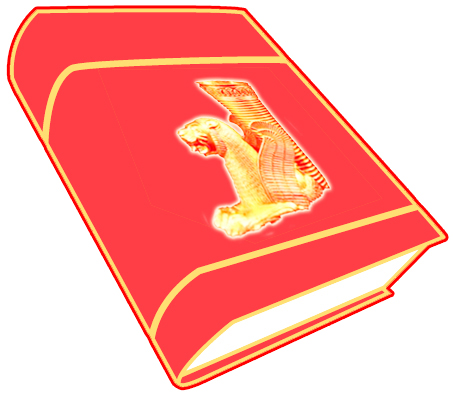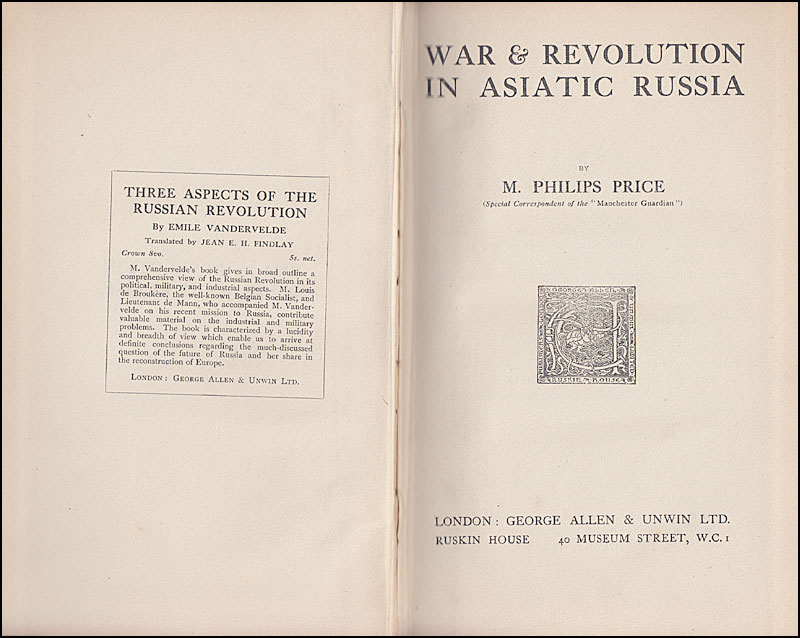
WAR & REVOLUTION IN ASIATIC RUSSIA
1917

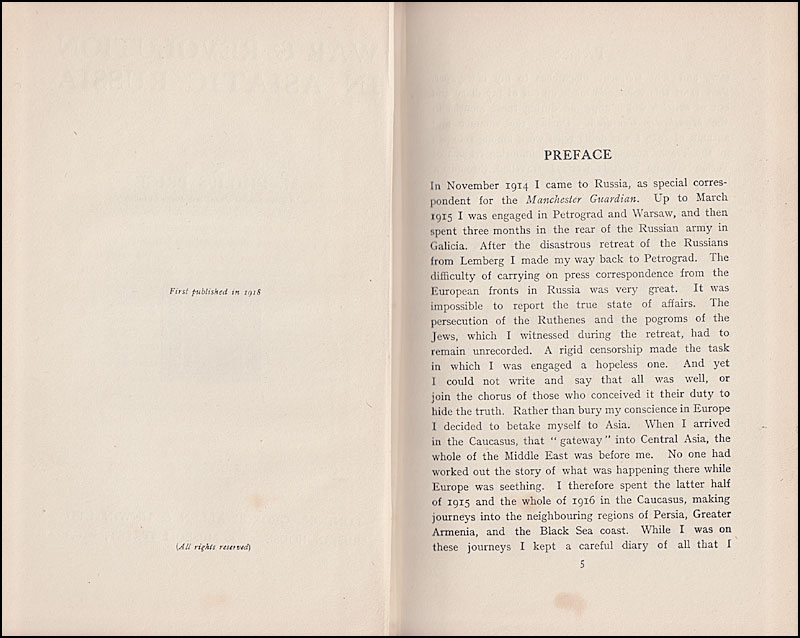
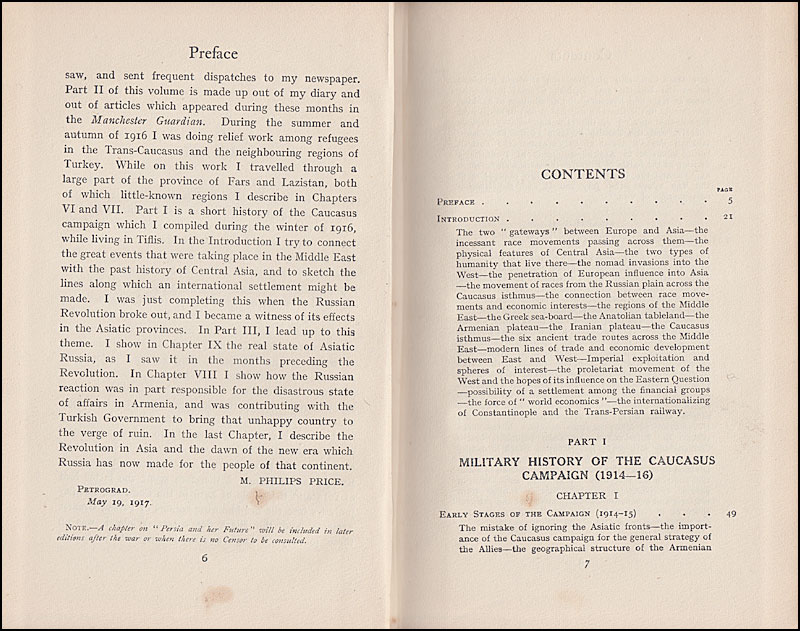
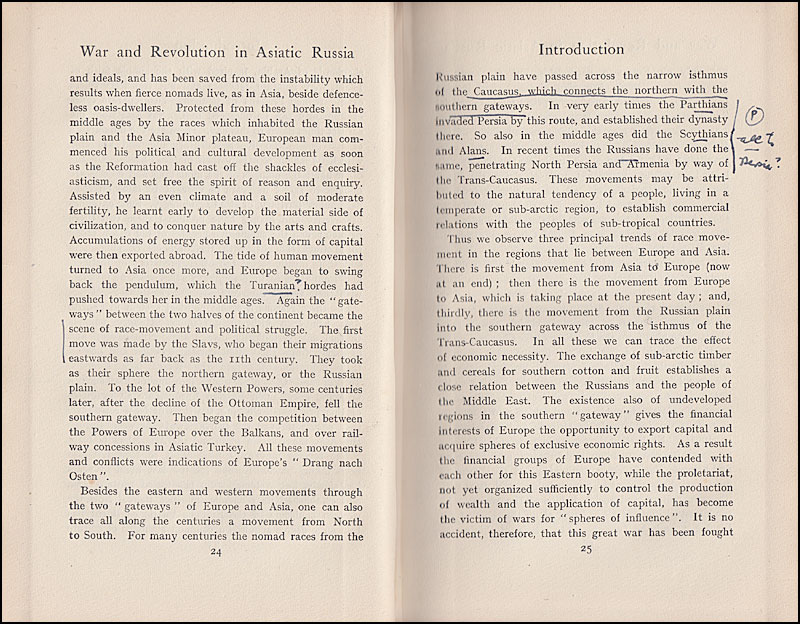
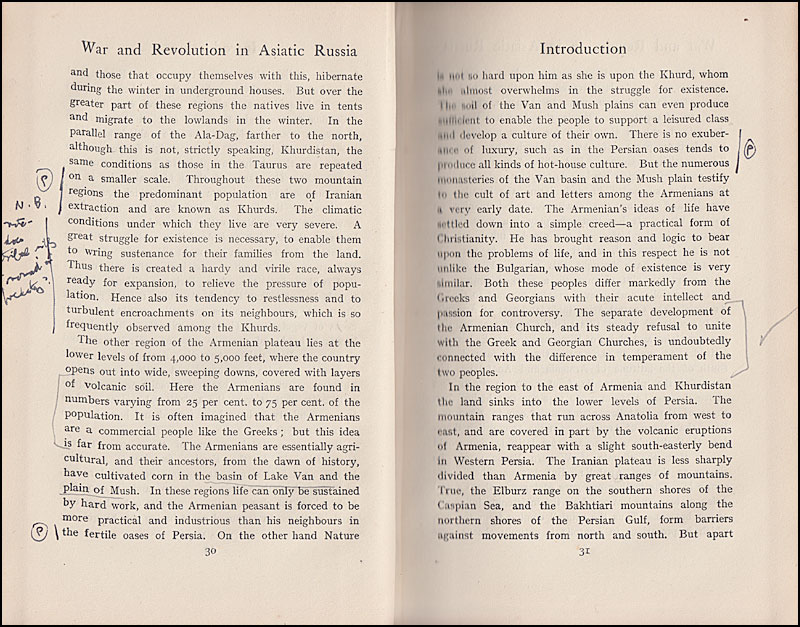
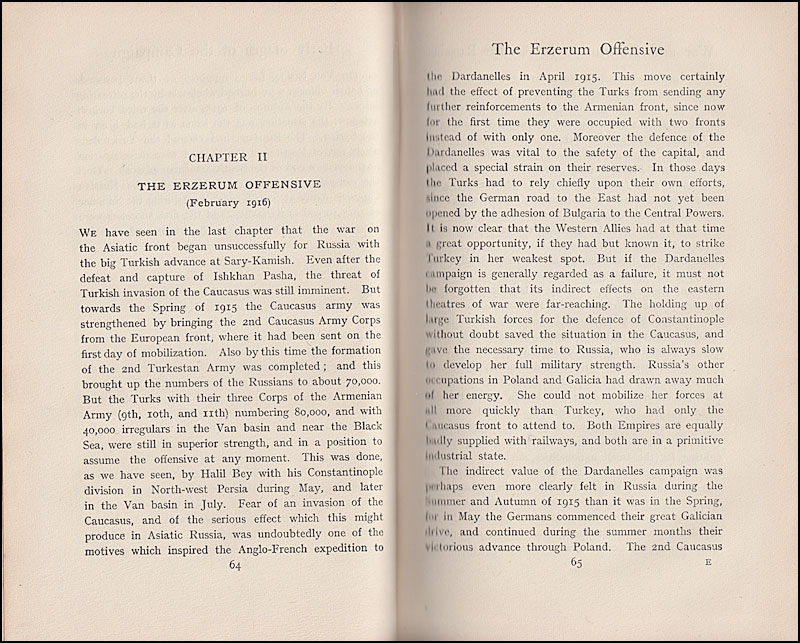
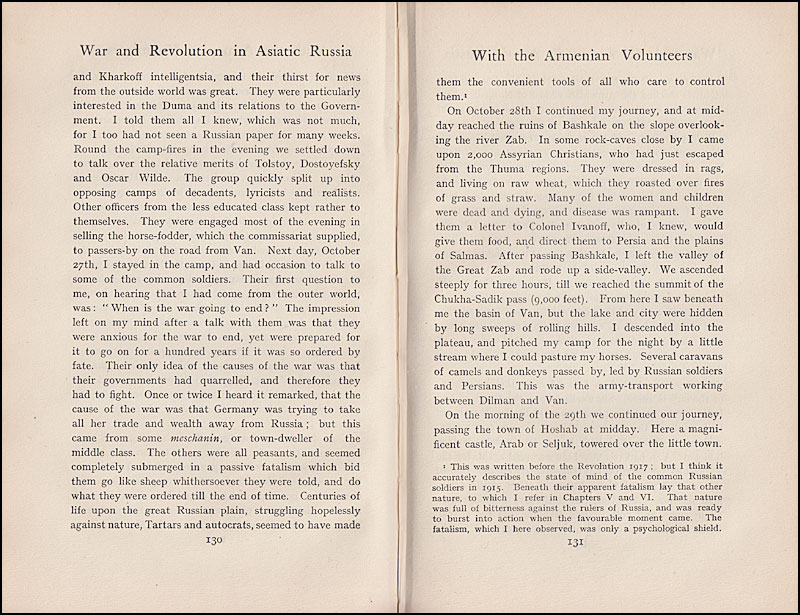
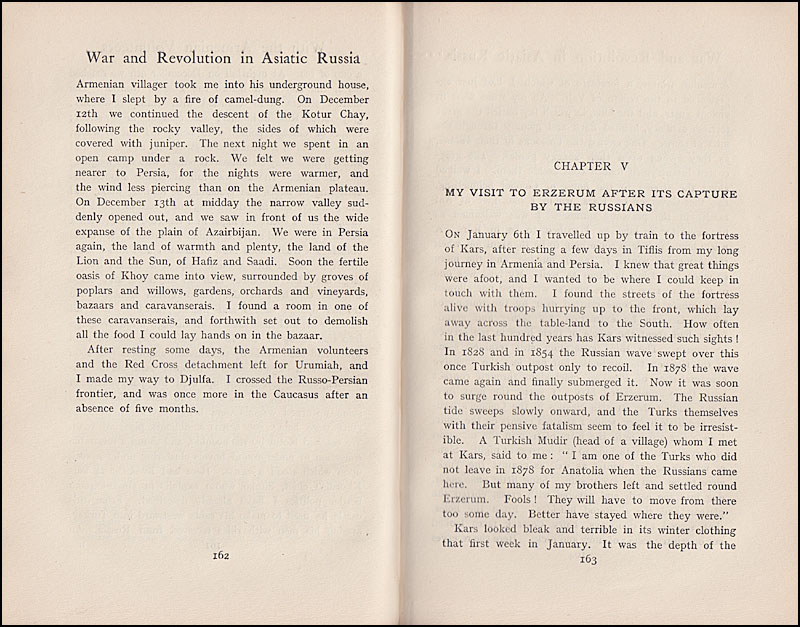
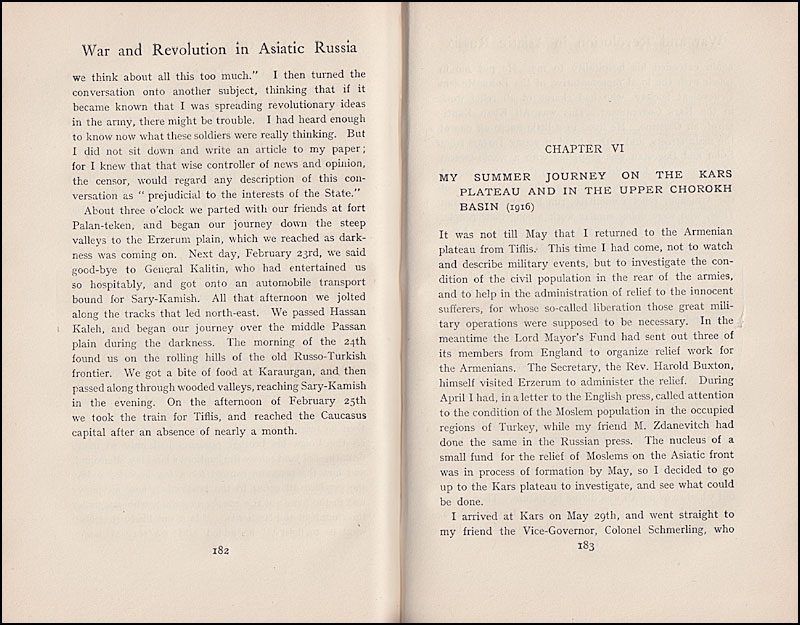
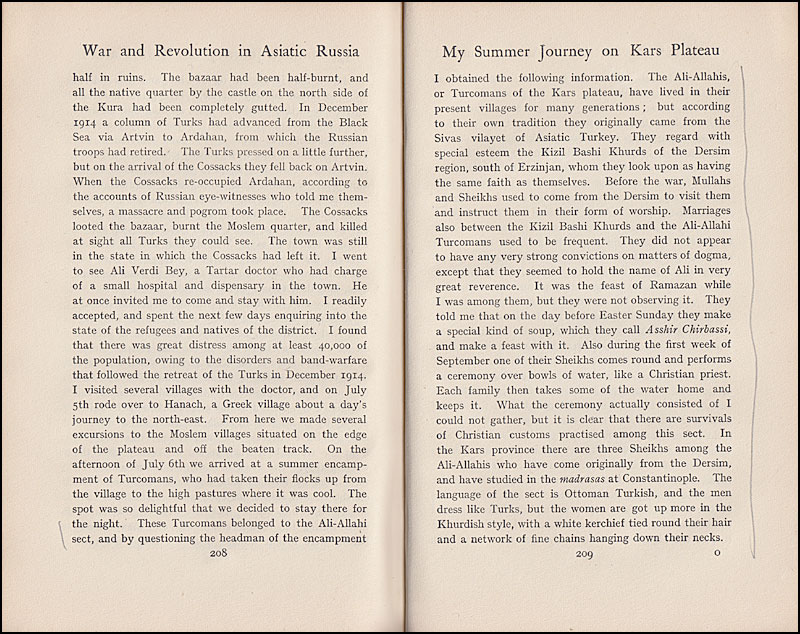
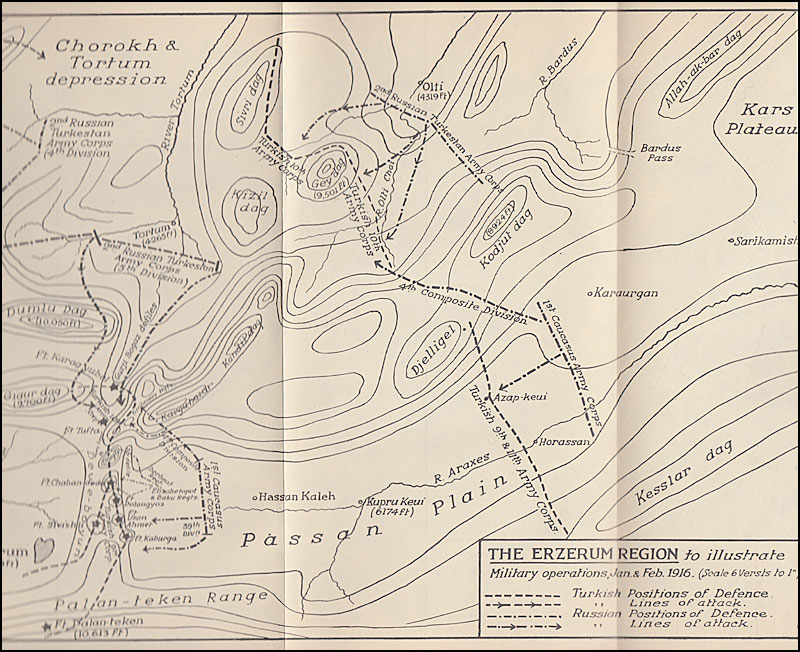
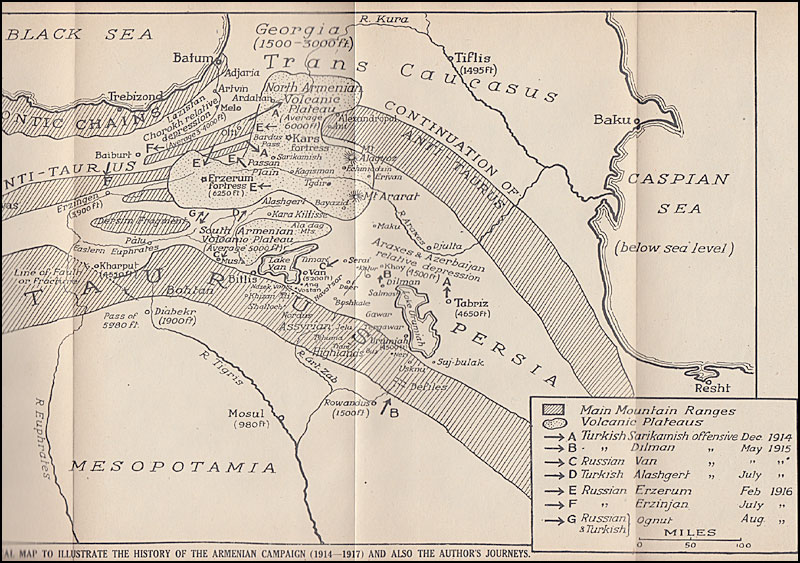
War & Revolution in Asiatic Russia
Contents
Preface
Introduction
The two " gateways " between Europe and Asia — the incessant race movements passing across them — the physical features of Central Asia — the two types of humanity that live there— the nomad invasions into the West — the penetration of European influence into Asia — the movement of races from the Russian plain across the Caucasus isthmus — the connection between race movements and economic interests — the regions of the Middle East — the Greek sea-board — the Anatolian tableland — the Armenian plateau — the Iranian plateau — the Caucasus isthmus — the six ancient trade routes across the Middle East — modem lines of trade and economic development between East and West — Imperial exploitation and spheres of interest — the proletariat movement of the West and the hopes of its influence on the Eastern Question — possibility of a settlement among the financial groups — the force of " world economics " — the internationalizing of Constantinople and the Trans-Persian railway.
PART I
MILITARY HISTORY OF THE CAUCASUS CAMPAIGN (1914—16)
Chapter I
Early Stages of the Campaign (1914-15)
The mistake of ignoring the Asiatic fronts — the importance of the Caucasus campaign for the general strategy of the Allies — the geographical structure of the Armenian and Trans-Caucasian plateaux — the strategic problems before the Russian and Turkish General Staffs — the bases at Kars and Erzerum — the possibilities of flanking movements in the Chorokh depression and in north-west Persist — the opening of the campaign — Enver Pasha's offensive and the Turkish invasion of the Caucasus — Ishkhan Pasha's defeat at Sary-Kamish — the Turkish spring offensive in Azairbijan— defeat of Halil Bey's division at the battle of Dilman — the Armenian rebellion at Van and the Russian advance — their occupation of the Van vilayet — the July retreat and the Russian reoccupation of Van.
Chapter II
The Erzerum Offensive (February 1916)
General state of the Caucasus army during 1915 — danger of a Turkish concentration — great value of the Anglo-French expedition at the Dardanelles in saving the Caucasus army — the Grand Duke Nicolas succeeds in strengthening the Asiatic fronts — Turkish concentration against British in Mesopotamia and consequent weakening of their forces in Armenia — the opportunity for the Caucasus Army — the fortress of Erzerum and its physical surroundings — Turkish dispositions and plan of defence — the Russian dispositions and plan of attack — the capture of the Azap-keui positions — retreat of the Turks to the Deve-boyun — Halid Bey's counter-attack in the Chorokh depression repulsed by the Russian Turkestans — Russian advance a semi-circular line 130 miles long — difficulties of holding the line across the high mountain ranges — attack of the ist Caucasus Army Corps on the Deve-boyun positions — capture of outer forts — Turks repulse the Elizabetopol and Baku regiments before Chaban-dede with heavy loss — Russian attack in danger of breaking down — wonderful feat of the 4th Composite Division in crossing the Kargar-bazar heights and joining the 2nd Turkestans — forts Chaban-dede and Tufta in danger of being surrounded — Turkish retreat from the forts and evacuation of Erzerum — moral and political effect of the capture of Erzerum — its strategic value for the campaign in Asia.
PART II
DIARY OF AUTHOR'S JOURNEYS
Chapter III
With the Russian Expedition in North-West Persia and Khurdistan
I leave Tiflis — visit Ani — ascend Mount Alagyoz — visit Echmiadzin and the Armenian Catholicos — reach Djulfa and cross the Persian frontier — arrive at Tabriz — the political atmosphere there— educational revival among the Persians — I buy horses and make up my caravan — start off from Tabriz — reach the Lake of Urumiah — visit Dilman — a town without a governor — visit General Chemozubof — start off for the town of Urumiah — the Russian retreat in progress and the flight of the Assyrian refugees — I reach Urumiah and find it unoccupied — am taken in by Dr. Packard at American Mission — story of the Khurdish invasion of Urumiah in the winter 1914 — the national movements among the Khurds — their habits and race movements along the Turco-Persian border — evil effect of Russian and Turkish political intrigues on the morale of the Khurds — history of Simko — the Russian Consul in Urumiah declares an amnesty to the Khurds just after my arrival — I accompany Dr. Packard on a mission to pacify the Khurds — we visit the Begzadis of Mergawer — meet the armed tribesmen at Dize — are escorted to the chief — spend the night with Abdull a Agha — secure a passage for the Assyrian Christians — return to Urumiah — go out again to meet Bedr Khan Bey — bring him in to the Russian Consul — visit the Begzadis of Tergawer — ride up on to the high plateau — meet the outposts of Khurdu Bey — arrive in his camp — rare received with Oriental pomp — discover Turkish agents in the camp — discover great loot from Urumiah — negotiate with Khurdu Bey — the fanatical sheikh — Khurdu Bey agrees to release his Christian slaves — bring the Christians back to Urumiah — the American Mission in Urumiah, its history and work.
Chapter IV
With the Armenian Volunteers round Lake Van
I return to Dilman — witness the retreat of the Assyrians into Persia — visit their Patriarch and hear his story — history of the Assyrian Christians — start out for Armenia — reach the valley of the Great Zab — visit the monastery of Deer — spend a few days in a Russian camp — cross the Chukha-Sadik pass — my first sight of Lake Van — I reach the city — meet the Armenian volunteers under Ishkhan — join the Red Cross detachment — we start out for the front — in camp at Shah-bagi — I visit the great rock at Van — the inscription of Xerxes — we start for the front — pass the camp of Andranik — my interview with the Armenian revolutionary leader — types of Armenian revolutionaries — we go into camp at Ang— our life there — life in the neighbouring camps — a review of the troops — three Armenian scouts come into camp — they tell us stories of the Turks — Yegishey tells me stories about the Khurds — the orders for advance come — our column on the march — we reach the headwaters of the Tigris — come to a desolate upland plateau — our first sight of the Turks — descend into a deep valley — camp in the darkness beneath the Turks — an outpost affair — attacking the Turks in the early morning — we gain the summit of the pass — a gorgeous panorama — witness the advance of the Russian columns from the pass — a great battle scene — descend towards the lake — the attack on the following day — I witness the bombardment from the artillery observation post — talk with my friends among the infantry just before the attack — witness the attack from a hill — the capture of Narek Vank by the Armenians — walk over the field of battle — help a Cossack to bury a dead Turk — we all gather together in the evening — our fight against famine begins — we are caught in a blizzard — a terrible night at Vostan — the food arrives — we reach Van again — return to Persia — wayside scenes at Serai and in the Kotur defiles — reach the oasis of Khoy — I return to the Caucasus.
Chapter V
My visit to Erzerum after its Capture by the Russians
I arrive at Kars — I stay with the Vice-Governor — preparations for the advance — the Kars plateau in winter — news of the Erzerum offensive comes — I leave for Sary-Kamish — join my colleagues of the Russian press — start off in transport wagons — reach the Passan plain — the scenes in the wake of the advance — arrive at Kupru-koui — -the rumble of the artillery on the Deve-boyun — Hassan-kaleh — I climb on to the great rock — scenes on the upper Passan — the ravages of war and changes of nature — we are received by General Eudenitch — reach the Deve-boyun chain — a distant view of a rear-guard action — arrive in Erzerum — scenes in the street — start out to visit the forts — inspect the old Turkish guns — ascend the high plateau — terrible cold — the abandoned Turkish batteries — dead bodies in the snow— the last sleep of two Russian and Turkish peasants — we reach fort Chaban-dede — the great panorama of the Deve-boyun — sleep in the highest fort in the world — visit the snow-fields on the Olugli — the scene of the great struggle — return to Erzerum — I visit Mr. Stapleton — his heroic work with Mrs. Stapleton in the cause of the Armenians — Zdanevitch and I ride up to fort Palan-teken — view from the summit of the pass — with the soldiers in the fort at tea — we discuss the war — their attitude towards it — return to Erzerum — and to Tiflis.
Chapter VI
My Summer Journey on the Kars Plateau and in the Upper Chorokh Basin (1916)
The organization of relief work for sufferers from the war on the Caucasus front — I go to Kars to investigate the state of the refugees — the population of the Kars plateau — relations between the races before the war — disastrous moral effect of the war upon them — material losses of both Moslems and Armenians — impossibility of attaching the blame now — international commission desirable to make restitution to occupied regions of Turkey from a common fund of all belligerent countries — I visit Moslem villages — the Khurdish population of the Kars plateau — the Ali-Aliahi sect — tendency of the Moslem sects in this region to unite since the war into one national group — I set out on a journey to the Chorokh — springtime on the high plateaux— the ruined villages — I cross the Allah-ak-bar pass — magnificent view of the Kars plateau and the Olti depression — descend through pine forests to the village of Arsenek — am entertained by the Turkish peasants — their political outlook — " Who is our Padishah?"—! reach Olti — start out with M. Kuzetsef for the Upper Chorokh — we pass the Gey Dag — Russian engineering feats in the Upper Chorokh and the strategical value of the new roads — reach Tortum — tea under the mulberry-trees — I climb up to the old castle — find ruins of a Christian church — probabilities of the ancient Georgian frontiers being once here — investigate the condition of the natives — estimate of the population and its losses from the war — we cross the Kazan Dag — magnificent view of the whole Upper Chorokh basin — reach the Staff of General Prejvalsky — the " peasant-general " and his character — discuss the native racial problems in Asia — I see the refugees — we return to Tortum valley — population seen en route — return to Olti — on the road to Kars again — I travel with Russian peasant soldiers — their views on the war — fatalism and the military machine — visit the Kars prison — A Russian conscientious objector — reach Ardahan — condition of the town and district — effect of the war on the native population — visit the summer encampment of the Ali-Aliahi sect — their religious practices — visit Turkish villages — their views on the Arab rebellion against the Sultan and the Caliphate — visit the vUlages of the Russian Dissenters — a typical Malakan village — history of their sect — their high moral character — their progressive "habits — their high standard of husbandry — its effect on the Asiatic natives — their social relation with their Armenian and Moslem neighbours.
Chapter VII
Work among the Refugees in Lazistan
I buy food and warm clothing for the Lazis — Dr. Sultanof and I arrive at Batum — difficulties of transporting our material to Lazistan — the geographical structure of Lazistan — history of Lazistan — Tamara's dream — probable population of Lazistan — effect of the Turkish retreat and the Russian occupation on the natives of Lazistan — we reach Morgul — we can get no farther — the natives save us trouble by carrying all the food on their backs-r-capacity of the Lazi for carrying heavy weights — we pass through lower Adjaria — ruined and deserted condition of the country — history of the Turkish invasion here at commencement of war — the return of the Russians — the massacre of the Ad jars — statistics for the population of Adjaria — we reach Artvin — wonderful situation of the town — we stay with Captain Zasemovitch —the inhabitants of Artvin — the Catholic Armenians and their history — set out for Lazistan — a wonderful pass — see all Adjaria and the Caucasus range at one glance — our first sight of Lazistan — look into an abyss — descend two thousand feet sheer — reach Melo, the first village of Lazistan — meet the Russian officials — " I don't know where my district ends " — terrible condition of the natives — we distribute our food and clothing — walk on foot farther up the gorges — reach a true Lazi village — starving people wish to entertain us — the Lazi, his life and habits, his character and the beauty of his women — we find Greek Christians — their underground church and secret custom — return to Batum.
PART III
POLITICAL
Chapter VIII
The Armenian Question and its Settlement
Armenia's fate between two Imperial Powers — the Eastern Question in relation to Armenia — the weakness of Turkey's rule in Armenia and its cause — -the three social elements in the population of Armenia — Turkish incapacity to assimilate — the Turkish Revolution and the two political parties in Constantinople — liberal nationalism and the party of Enver Pasha — proposal for peaceful solution of Balkan Question — Russian policy at Constantinople and M. Charikos — attitude of Russian authorities in Caucasus — the raising of the question of Armenian autonomy — failure of the proposal — the Balkan war — triumph of Enver Pasha's party — the policy of blood and iron — process of natural reconciliation between Khurd and Armenian— effect of Powers' Armenian reform scheme on this reconciliation — the outbreak of the European war — the Erzerum conference — Young Turk Committee's proposal to the Armenians — the " chain of buffer States " in the Caucasus — Turkish Government's pretexts for demands on Armenians — the Armenian volunteer movement in the Caucasus and its origin — disagreement among the Armenians on questions of policy — the Armenian massacres — probable number of survivors — the losses of the Khurds and Moslems during the war — the losses of the Assyrian Christians — race movements in Armenia resulting from wars in last hundred years — figures of Armenian and Khurdish population of Armenia before the war — the pressure of the Khurds on the Armenians and its economic causes — the problem of the future race settlement — need for re-establishing friendly relations between Armenians and Khurds — right of people of Armenia to decide their own fate — need to summon a Khurdo-Armenian assembly — the future political structure — will natives decide for union with Turkey or with Russia? — reasons for preferring union with Russia.
Chapter IX
Nationalism and Internationalism in the Caucasus
The development of nationalism among small races as result of Imperialist policies of Great Powers — the principle of " Divide et impera " — national revival in Caucasus and Middle East during eighteenth century — its purely cultural aspect in its early stages — the growth of political nationalism — it spreads from Europe to the Near and then the Middle East — the effect of the Russian Revolution of 1905 on the Near and Middle East — the beginnings of the proletariat " international " movement and its speedy collapse — the Russian reaction and its policy for dealing with revolutionary movements — development of an aggressive nationalism among races of Caucasus as result of the crushing of the proletariat revolution — the Nationalist parties among the Armenians — the Nationalist parties among the Georgians — Nationalist movements among the Tartars— their development of political self-consciousness — the two forms of Pan-Islam movement, the political and the cultural — nationalism in the Caucasus after the outbreak of the great war — the balance of power between the races — influx of the Armenian refugees from Turkey and its effect on creation of Tartar-Georgian Block — policy of Russian authorities embitters the national feuds — Prince Vorontsoff-Dashkoff and the Alashkert Cossack proposal — the Grand Duke Nicolas introduces the Zemstvo scheme — attitude of Armenian Nationalists — attitude of Tartar-Georgian aristocracy — attitude of Social-Democrat parties — the Grand Duke and landowning classes insist on conservative franchise — beginnings of rapprochement between Caucasian nationalities during winter 1916-17 — the strengthening of the international-revolutionary movement in response to developments in Russia — the March Revolution in the Caucasus and the appearance of the Council of Workers and Soldiers' Delegates — the attitude towards it of the Armenian and Georgian Socialist societies — the reactionary forces among the Georgian aristocracy — the Armenian bourgeoisie and the Russian Liberal Imperialists — the difficulty of reconciling the National with the International movements in the. Caucasus — the possibility of a compromise on the basis of federation.
Chapter X
The Russian Revolution and its Effects in Asia
The Russian reaction and the war — suppression of movements for liberty — persecution of small nationalities — the responsibility of the " Northcliffe " Press in its relations with the Russian Government — the apparent hopelessness of the revolutionary movement in Russia — the rebellion of the natives of Central Asia against Russia in 1916 — the decisive factor was the food crisis — statistics showing the depletion of Russia's food supplies as the result of the war — the approach of famine and its effect in reviving the revolutionary movement — the three social elements in Russia on the eve of the Revolution — (1) the peasant proletariat — (2) the aristocracy, higher bureaucracy, and the Court party — their desire for a separate peace as a means of crushing revolution — English support of the Russian reaction— the " Northcliffe " Press and its sympathy for Nicolas II— (3) the Russian middle-class parties and the Progressive Block— their capitalist connections and Imperialist aims— their estrangement from the peasant proletariat— the " intelligentsia," and its union with the middle classes — the social elements in Asiatic Russia on the eve of the Revolution — in Siberia — in Turkestan and Bokhara — in the Caucasus — spread of the revolutionary movement in the Caucasus during the winter 1916-17 — the Government's attempts to suppress it — the collapse of the economic system — the appearance of brigandage and famine — mutiny among the troops — plan for the advance on Nosul across Persia falls through on account of impossibility of feeding troops — the British advance on Bagdad alone — first news of the revolution in Petrograd reaches the Caucasus — the Socialist-Revolutionary societies in Tiflis seize the reins of government — garrison goes over to the revolution — the great meeting in the Nahalofsky Square on Sunday March i8th — the gathering of all the races of the Caucasus — I witness the first elections for the Caucasus Union of Soldiers' and Workers' Delegates — observe its proletariat and anti-Bourgeois attitude from the outset — listen to peace speeches welcoming the immediate establishment of the International — receive a note to call on the Grand Duke Nicolas — meet the Grand Duke in the palace — his agitated appearance — he informs me that he recognizes the new regime in Russia — send off a telegram — find the palace surrounded by revolutionary guards — the Grand Duke becomes virtually a prisoner — his Cossacks go over to the revolution — he leaves for Europe — his character — his attitude towards democratic movements — his desire for a palace revolution to preserve the autocracy — I leave for Kars — meet a Tartar friend on the platform — " We have arrested them all " — see Kars in the hands of the revolutionaries — find my friend the Vice-Governor arrested — visit the executive of the Kars revolutionary Committee — notice the reconciliation of nationalities formerly hostile — see Tartars, Armenians, and Russians serving on the same committees — visit the Council of Soldiers' Delegates — return to Tiflis — the Tiflis Revolutionary Committee gets to work — its syndicalist method of formation — visit Mtschet — the Georgians decide to elect their own Exarch — visit Elizabetopol for a Conference of the Tartars — news arrives about the progress of the revolution in Central Asia — the Turkestan Council of Workers' and Soldiers' Delegates is formed — native Mohammedans work with representatives of Russian soldiers and colonists — the preliminary programme of the Turkestan Council — equal rights for all nationalities — reversal of the " colonial " policy — the arrest of the Governor-General — the revolution reaches Bokhara — the Emir's attempt to crush it — the Russian Resident supports him — the arrival of the revolutionary soldiers from Tashkent and Samarkand — the Emir of Bokhara declares a Constitution — the revolution among the Cossacks — I cross the Cossack steppes — observe the formation of the Council of Soldiers' Delegates among the Cossacks — mountain tribesmen and Cossacks serve on the same Committee — Tersk Cossacks declare for a republic — causes of the spread of revolutionary ideas among the Cossacks — the widespread influence of the Russian Revolution in Asia — the downfall of old despotisms — its influence on India — will Western Europe follow the Star in the East ?War & Revolution in Asiatic Russia
Preface
In November 1914 I came to Russia, as special correspondent for the Manchester Guardian. Up to March 1915 I was engaged in Petrograd and Warsaw, and then spent three months in the rear of the Russian army in Galicia. After the disastrous retreat of the Russians from Lemberg I made my way back to Petrograd. The difficulty of carrying on press correspondence from the European fronts in Russia was very great. It was impossible to report the true state of affairs. The persecution of the Ruthenes and the pogroms of the Jews, which I witnessed during the retreat, had to remain unrecorded. A rigid censorship made the task in which I was engaged a hopeless one. And yet I could not write and say that all was well, or join the chorus of those who conceived it their duty to hide the truth. Rather than bury my conscience in Europe I decided to betake myself to Asia. When I arrived in the Caucasus, that " gateway " into Central Asia, the whole of the Middle East was before me. No one had worked out the story of what was happening there while Europe was seething. I therefore spent the latter half of 1915 and the whole of 1916 in the Caucasus, making journeys into the neighbouring regions of Persia, Greater Armenia, and the Black Sea coast. While I was on these journeys I kept a careful diary of all that I saw, and sent frequent dispatches to my newspaper. Part II of this volume is made up out of my diary and out of articles which appeared during these months in the Manchester Guardian. During the summer and autumn of 1916 I was doing relief work among refugees in the Trans-Caucasus and the neighbouring regions of Turkey. While on this work I travelled through a large part of the province of Fars and Lazistan, both of which little-known regions I describe in Chapters VI and VII. Part I is a short history of the Caucasus campaign which I compiled during the winter of 1916, while living in Tiflis. In the Introduction I try to connect the great events that were taking place in the Middle East with the past history of Central Asia, and to sketch the lines along which an international settlement might be made. I was just completing this when the Russian Revolution broke out, and I became a witness of its effects in the Asiatic provinces. In Part III, I lead up to this theme. I show in Chapter IX the real state of Asiatic Russia, as I saw it in the months preceding the Revolution. In Chapter VIII I show how the Russian reaction was in "part responsible for the disastrous state of affairs in Armenia, and was contributing with the Turkish Government to bring that unhappy country to the verge of ruin. In the last Chapter, I describe the Revolution in Asia and the dawn of the new era which Russia has now made for the people of that continent.
M. PHILIPS PRICE.
Petrograd.
May 19, 1917.
